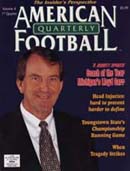AMERICAN FOOTBALL MONTHLY THE #1 RESOURCE FOR FOOTBALL COACHES
Article CategoriesAFM Magazine
|
Pay AttentionSteps and Hints to Aid Concentration in Kickersby: Nancy Halliday, Ph.D., by: Steven Frierman, Ph.D. Hofstra University © More from this issue In order to be a successful football player, one must be able to focus his attention on the right cues at the right time. The position a player plays often determines whether that player's focus of attention should be broad (large) or narrow (small), internal (from within), or external (from outside sources, i.e. teammates, opponents, playing surface). The purpose of this article is to focus on the kicker. Here are some guidelines to help increase your kicker's ability to direct his attention to the right cues and increase his chances for success by avoiding costly errors. Practice kicking until it becomes automatic. Making skills automatic requires systematic practice of the important parts of the skill. Making kicking skills automatic frees up attentional "space" for other important aspects of the performance. Be....The full article can only be seen by subscribers.
|
|
|||||||
| HOME |
MAGAZINE |
SUBSCRIBE | ONLINE COLUMNISTS | COACHING VIDEOS |
Copyright 2025, AmericanFootballMonthly.com
All Rights Reserved





